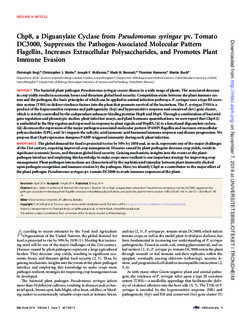| dc.contributor.author | Engl, C | |
| dc.contributor.author | Waite, C. | |
| dc.contributor.author | McKenna, J | |
| dc.contributor.author | Bennett, M | |
| dc.contributor.author | Hamann, Thorsten | |
| dc.contributor.author | Buck, M. | |
| dc.date.accessioned | 2019-11-08T07:56:28Z | |
| dc.date.available | 2019-11-08T07:56:28Z | |
| dc.date.created | 2014-10-15T12:37:52Z | |
| dc.date.issued | 2014 | |
| dc.identifier.issn | 2161-2129 | |
| dc.identifier.uri | http://hdl.handle.net/11250/2627289 | |
| dc.description.abstract | The bacterial plant pathogen Pseudomonas syringae causes disease in a wide range of plants. The associated decrease in crop yields results in economic losses and threatens global food security. Competition exists between the plant immune system and the pathogen, the basic principles of which can be applied to animal infection pathways. P. syringae uses a type III secretion system (T3SS) to deliver virulence factors into the plant that promote survival of the bacterium. The P. syringae T3SS is a product of the hypersensitive response and pathogenicity (hrp) and hypersensitive response and conserved (hrc) gene cluster, which is strictly controlled by the codependent enhancer-binding proteins HrpR and HrpS. Through a combination of bacterial gene regulation and phenotypic studies, plant infection assays, and plant hormone quantifications, we now report that Chp8 (i) is embedded in the Hrp regulon and expressed in response to plant signals and HrpRS, (ii) is a functional diguanylate cyclase, (iii) decreases the expression of the major pathogen-associated molecular pattern (PAMP) flagellin and increases extracellular polysaccharides (EPS), and (iv) impacts the salicylic acid/jasmonic acid hormonal immune response and disease progression. We propose that Chp8 expression dampens PAMP-triggered immunity during early plant infection. | nb_NO |
| dc.language.iso | eng | nb_NO |
| dc.publisher | American Society for Microbiology | nb_NO |
| dc.rights | Navngivelse 4.0 Internasjonal | * |
| dc.rights.uri | http://creativecommons.org/licenses/by/4.0/deed.no | * |
| dc.title | Chp8, a diguanylate cyclase from pseudomonas syringae pv. Tomato DC3000, suppresses the pathogen-associated molecular pattern flagellin, increases extracellular polysaccharides, and promotes plant immune evasion | nb_NO |
| dc.type | Journal article | nb_NO |
| dc.type | Peer reviewed | nb_NO |
| dc.description.version | publishedVersion | nb_NO |
| dc.source.volume | 5 | nb_NO |
| dc.source.journal | mBio | nb_NO |
| dc.source.issue | 3 | nb_NO |
| dc.identifier.doi | 10.1128/mBio.01168-14 | |
| dc.identifier.cristin | 1164193 | |
| dc.description.localcode | This is an open-access article distributed under the terms of the Creative Commons Attribution 3.0 Unported license. | nb_NO |
| cristin.unitcode | 194,66,10,0 | |
| cristin.unitname | Institutt for biologi | |
| cristin.ispublished | true | |
| cristin.fulltext | original | |
| cristin.qualitycode | 1 | |

